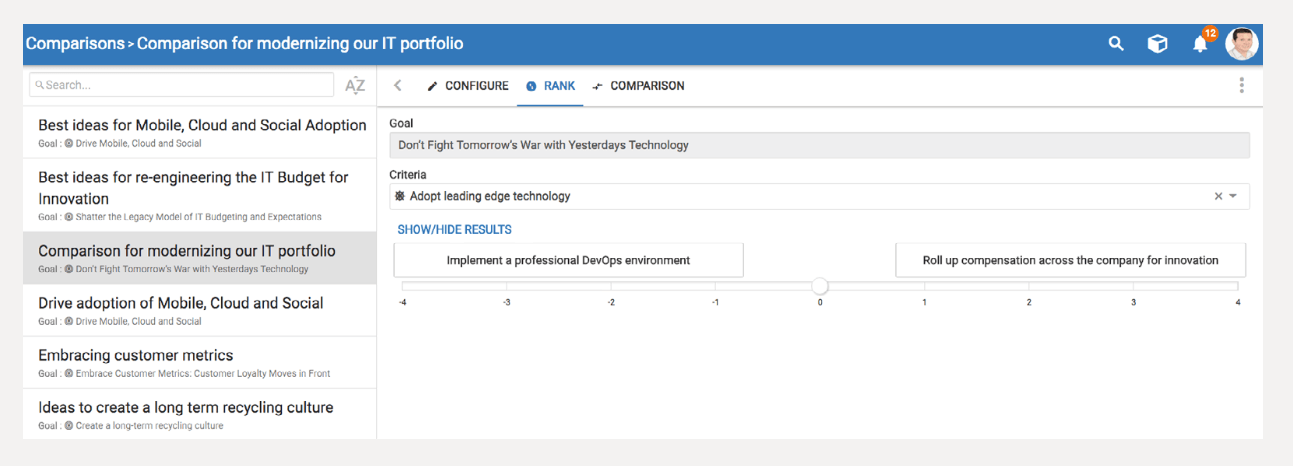What Is the Analytic Hierarchy Process?

The analytic hierarchy process (AHP) or pairwise comparison is a framework for decision making, rooted in mathematics and psychology. The widely used technique was created by Thomas L. Saaty, a Distinguished University Professor at the University of Pittsburgh, in the 1970s.
Saaty recognized that making decisions is complicated. Knowing how to make the “right” decision is even harder. The AHP is applied as an attempt to introduce structure into the organization and analysis of complex decisions.
The aim of the analytic hierarchy process is not to provide just one unique, correct decision. Rather, the AHP is a framework for structuring a problem (based around decision-making), relating it to overall goals and providing solution alternatives by allowing a group to map a decision to a particular goal or objective.
When applied correctly, the end result should be a rational decision based on the organization’s goals, and any concept can be ranked and compared within the context of a suitable goal.
The Analytic Hierarchy Process in Practice
The application of AHP begins with users decomposing their decision problem into hierarchy sub-criteria, each of which can be analyzed separately.
The concepts within the hierarchy can relate to any aspect of the decision problem; tangible or intangible, carefully measured or roughly estimated, well or poorly understood—anything at all that applies to the decision at hand.
Once the AHP is built, the decision makers (users) systematically evaluate its various elements by comparing them to one another two at a time (Pairwise comparison), with respect to their impact on a concept (criteria) above them in the hierarchy.
In making the comparisons, the decision makers typically use their judgments about the elements’ relative meaning and importance.
It is the fundamental foundation of the AHP technique that human decisions, and not just the underlying data, can be used in performing the evaluations.
It is typical that a question is defined at the criteria level of the hierarchy to guide the decision maker in making the qualitative assessment between the two concepts.
For example, “Which idea helps adoption for driving mobile, cloud and social in our company?”
The AHP framework provides a numerical value for each set of concepts that are part of a pairwise comparison. This technique allows diverse and often incommensurable elements to be compared to one another in a rational and consistent way.
This capability distinguishes the AHP from other decision-making techniques.
Once all concepts have been compared, AHP provides an overall ranking for each concept with the context of the entire problem, for each of the decision alternatives. These numbers represent the alternatives’ relative ability to achieve the goal, so they allow a straightforward consideration of the various courses of action.
Although it has benefits for team decision-making, it can be used by individuals working on straightforward decisions. However, the analytic hierarchy process (AHP) is definitely more beneficial where communities of people are working on complex problems.
It has unique advantages when important elements of the decision are difficult to quantify or compare, or where communication among team members is impeded by their different specializations, terminologies, or perspectives.
Some possible ways AHP can be applied to decision making:
Choice: The selection of one alternative from a given set of alternatives, usually where there are multiple decision criteria involved.
Ranking: Putting a set of alternatives in order from most to least desirable
Prioritization: Determining the relative merit of members of a set of alternatives, as opposed to selecting a single one or merely ranking them
Resource allocation: Apportioning resources among a set of alternatives
Benchmarking: Comparing the processes in one’s own organization with those of other best- of-breed organizations
Quality management: Dealing with the multidimensional aspects of quality and quality improvement
Conflict resolution: Settling disputes between parties with apparently incompatible goals or positions
The Analytic Hierarchy Process In Enterprise Architecture
AHP’s rationality, inclusion of the “human factor” and collaborative approach to decision making have made the analytic hierarchy process popular, and it is now used around the world in a wide variety of decision making situations.
One example is enterprise architecture. Enterprise architects are encouraged to adopt the technique as a best practice.
Much like Kanban boards, the analytic hierarchy process isn’t an idea that grew out of enterprise architecture, but is one that enterprise architects have adopted to meet their needs.
The three key applications of the analytic hierarchy process in enterprise architecture are:
- Comparing, ranking ideas against each other to work out the most suitable for a goal
- Ranking initiatives to see which has the most value
- Comparing workspaces or solution alternatives for the best option
To learn more about enterprise architecture and the analytic hierarchy process, please see our free eBook on Enterprise Architecture and Innovation Management.
Enterprise Architecture & Innovation Management
This book, written by Martin Owen, erwin’s Senior Vice President of Product Strategy, and Alan Burnett, erwin’s Director of Worldwide Partner Enablement, explores innovation management and EA with techniques and best practices they’ve seen benefit clients during the past 20 years.
Get the eBook
